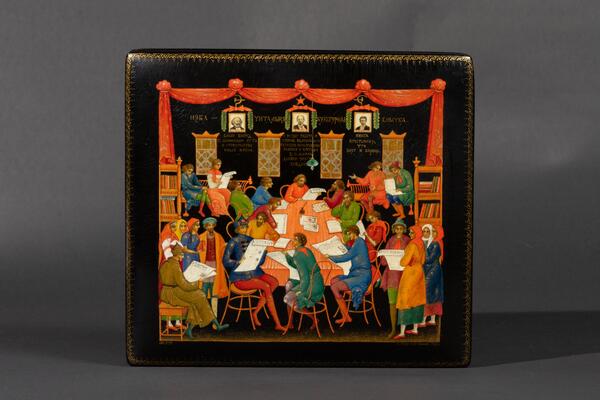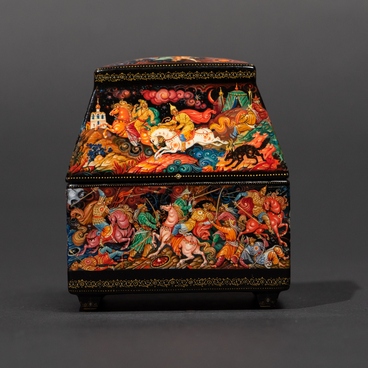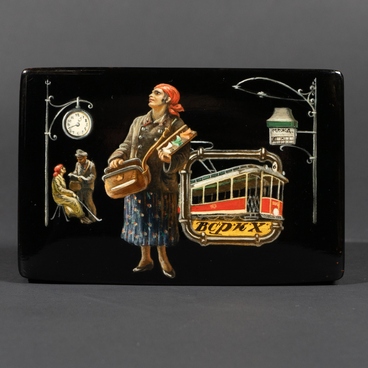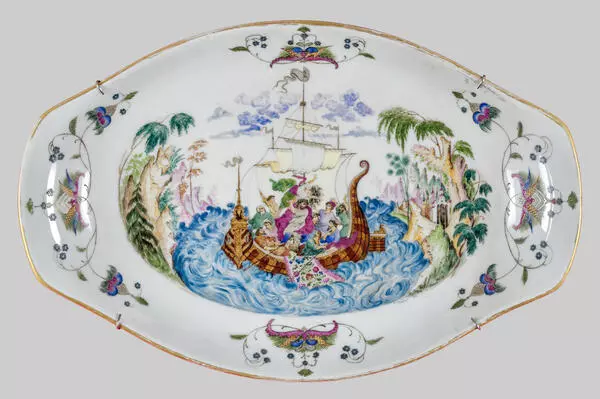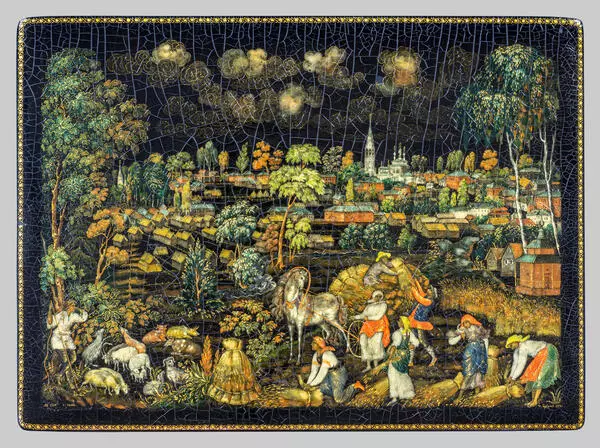In the first lacquer works, Palekh masters followed the themes of the 19th century miniature. It was dominated by the motifs of rural life; thus, many Palekh artists depicted scenes on agriculture and harvesting in the 1920s. However, other topics appeared as well: they reflected the most important political events.
Ivan Bakanov became one of the first artists who started to work with these topics. His box ‘Reading Room’ is a vivid example of this type of miniatures. He created it in 1925, when he was already an experienced artist.
Reading rooms, or literary ‘reading izbas’, appeared in the 19th century as educational centers for rural residents. Traditionally, they included various clubs and a library, often people staged performances, as well. Since the first years of Soviet power, their role in the life of society significantly increased: the government began a campaign to eradicate mass illiteracy (‘Likbez’ — elimination of illiteracy).
In those time, most people, especially villagers, were not able to read and write. On the initiative of Vladimir Lenin, since the summer of 1920, many small rural libraries were established throughout the country and literacy schools started working. Despite the lack of funds, new Soviet alphabet books were published. They were not only used to teach people to read and write, but also promoted new values. Students read their first words: ‘We are not slaves, slaves — are not us’, ‘Old times — work for the lord. New times — work for the world’.
Propaganda posters were placed everywhere and reminded of the importance of education: ‘Boldly Grab a Book, Comrade’, ‘If You Will Not Read Books, You Will Forget the Grammar! ’, ‘A Tractor Driver, a Milkmaid, a Cowman — You Are Not a Worker Without a Book! ’
Over time, the educational program achieved its goals and the reading rooms lost their significance. By the 1960s, they were replaced by rural clubs, cultural centers and libraries.
In this lacquer miniature, Ivan Bakanov depicted visitors of a reading room: they sift through Soviet newspapers and magazines. On the wall under a kumach curtain (bright red plain-weave cotton cloth) are three portraits: Karl Marx, Vladimir Lenin and Mikhail Kalinin.
The artist was a great colorist, his colors are comparable to medieval enamels in their purity. Experts also noted a special sense of proportion typical for him: his works were always distinguished by the harmonious colors and the balance of a rich composition.
Ivan Bakanov became one of the first artists who started to work with these topics. His box ‘Reading Room’ is a vivid example of this type of miniatures. He created it in 1925, when he was already an experienced artist.
Reading rooms, or literary ‘reading izbas’, appeared in the 19th century as educational centers for rural residents. Traditionally, they included various clubs and a library, often people staged performances, as well. Since the first years of Soviet power, their role in the life of society significantly increased: the government began a campaign to eradicate mass illiteracy (‘Likbez’ — elimination of illiteracy).
In those time, most people, especially villagers, were not able to read and write. On the initiative of Vladimir Lenin, since the summer of 1920, many small rural libraries were established throughout the country and literacy schools started working. Despite the lack of funds, new Soviet alphabet books were published. They were not only used to teach people to read and write, but also promoted new values. Students read their first words: ‘We are not slaves, slaves — are not us’, ‘Old times — work for the lord. New times — work for the world’.
Propaganda posters were placed everywhere and reminded of the importance of education: ‘Boldly Grab a Book, Comrade’, ‘If You Will Not Read Books, You Will Forget the Grammar! ’, ‘A Tractor Driver, a Milkmaid, a Cowman — You Are Not a Worker Without a Book! ’
Over time, the educational program achieved its goals and the reading rooms lost their significance. By the 1960s, they were replaced by rural clubs, cultural centers and libraries.
In this lacquer miniature, Ivan Bakanov depicted visitors of a reading room: they sift through Soviet newspapers and magazines. On the wall under a kumach curtain (bright red plain-weave cotton cloth) are three portraits: Karl Marx, Vladimir Lenin and Mikhail Kalinin.
The artist was a great colorist, his colors are comparable to medieval enamels in their purity. Experts also noted a special sense of proportion typical for him: his works were always distinguished by the harmonious colors and the balance of a rich composition.

